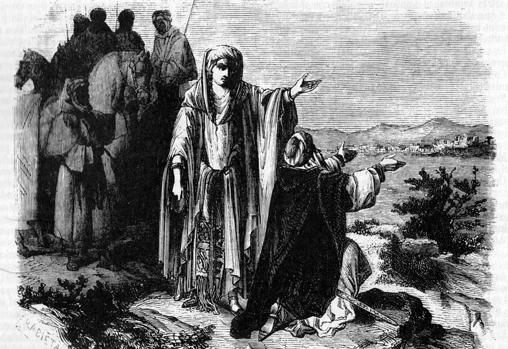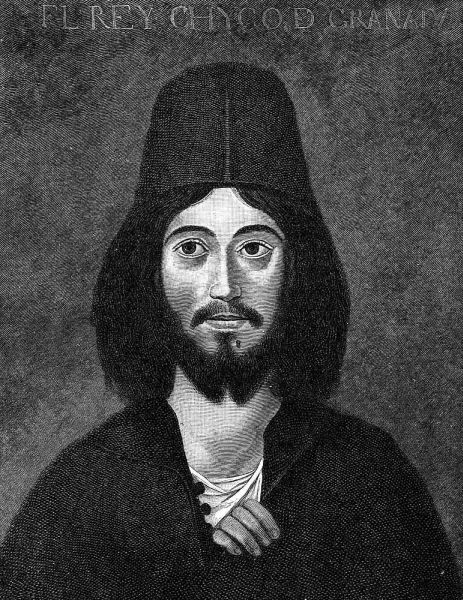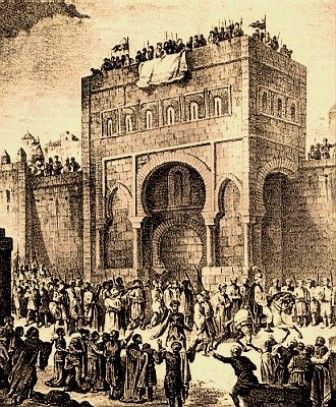Boabdil: the Sultan ally of the Catholic Kings who handed over Granada
Autor: César Cervera 12/24/2020Author: César Cervera
Boabdil, nicknamed by Christians as “El Chico” and by Muslims as “el Zogoibi” (the unfortunate one), handing over the keys to Granada is one of the favorite scenes of nineteenth-century historiography. The painter Francisco Pradilla reconstructed the episode in what is perhaps his best-known painting, “La rendicíon de Granada” (1882), which hangs today in the Senate Palace in Madrid. Despite the defeat, the Nasrid Sultan appears on the canvas with dignity and strength, in front of the majesty of the Catholic Monarchs and their troops. Thus rises, without historical basis, his figure to that of the sacrificed hero who was a victim of circumstances. Other representations and works of fiction present him, directly, as the last sentinel of a more sophisticated culture, before the arrival of the dirty Christian conquerors ready to destroy everything.
The result of this cocktail of clichés is that of the authentic Boabdil is only the myths are known. To begin with, the phrase his mother told him on the way to exile is false: “Cry like a woman for what you could not defend as a man”. Going further, Boabdil was not so much of an enemy to the Catholic Monarchs (if not an ally), that in exchange for reaching the throne he gave ground to the Christians and worked from within to hand over the city without violence.

Granada, a pending issue
Granada became the last Muslim stronghold in the Iberian Peninsula at the dawn of the Modern Age. Postponed during the unstable reigns of Juan II and Enrique IV, the conquest of Granada was placed as a priority for the Catholic Monarchs, architects of what modern Spain was intended to be. Isabella and Ferdinand had grown up under the threat posed by the rise of the Ottoman Empire, which in 1453 brought the fall of Constantinople, and they were unwilling to tolerate the challenge of Muley Hacen, the Emir of Granada, who during this period seized several strongholds on the Christian frontier and stopped paying the tribute stipulated with the Christians. Even the Arab chroniclers highlighted the bellicosity of this emir: “Magnanimous and courageous, lover of wars and the dangers and horrors they cause.”
When he got to know in Medina del Campo of the fall of Zahara, Ferdinand “El Católico” affirmed aloud: “I am sorry for the deaths of Christians, but I am glad to put into action very quickly what we had in mind to do”. This square, whose inhabitants were enslaved or killed, had been conquered by the Aragonese’s grandfather, Ferdinand of Antequera, in 1410. It was already a familiar matter for him to strike back.
Pope Sixtus VI supported the military enterprise by instituting a Crusade, as financial assistance. The bull of Crusade was extended every two years until reaching in its last year, 1492, a collection of 500 million maravedíes. The nobility, high clergy, and Jewish communities provided the rest of the funds. In addition, important economic remittances arrived from different European countries and, above all, German, English, Burgundian, knights and adventurers came… willing to participate in the last Crusade of the Christian West.

Nor was the popular support that the Granada Company had in Spain smaller. “Wherever they went, men, children, women, met them from everywhere in those fields and gave them a thousand blessings: they called them the protection of Spain (…)”, wrote Father Mariana about the popular fervor that unleashed as the troops passed by.
“Wherever they went, men, children, women, met him from everywhere in those fields and gave them a thousand blessings: they called them the protection of Spain (…)”
The Christians had numerical superiority and morale on their side, but the characteristics of the terrain prolonged a war of sieges and skirmishes, without major battles in the open field for six years. In this period of time, the Catholic Monarchs developed a military device, an administration and a tax system, which the final goal was a modern State that the kings of the House of the Habsburgs later used to achieve hegemony in Europe.
“The Boy King” sowed discord in Granada
During the first stage of the war, between 1482 and 1484, the improvisation and isolated performances of great Andalusian nobles, among them the Duke of Medina-Sidonia or the Count of Cabra, the older brother of Gonzalo Fernández of Córdoba, set a slow pace in the conflict. The Christian success improved in the second stage, as the the armies of Isabella and Ferdinand increased their services and conquered the valleys of Ronda, Loja, Marbella, Málaga, an essential port for the reception of supplies and reinforcements from North Africa, and Baza.
Apart from the fact that the Kings were associated at that time with prince Abu Abd Allah, known to the Spanish as Boabdil, “The Boy King“, who plunged the Muslim side into a civil war. Son of King Muley Hacen and Aixa, the sovereign’s cousin, Boabdil grew up under a long prophecy that affirmed, from his birth, that he would lead to death all those who loved him, and by his hands the crescent would end up turning into a cross… But it was not words, but something related to another woman, which alienated the heir from his father, Muley Hacen, who relegated Aixa to the background for a Christian concubine from his harem. Aixa, who tried unsuccessfully to kill the Christian woman and her children, incited Boabdil to rebel against his father using his many allies among the Nasrid aristocracy, since it must not be forgotten that she was a daughter of a previous sultan.

The severe Muley Hacen believed that Boabdil, a courteous man, “affable and of elegant manners”, was not fit to rule Granada, among other things because his temperament was little or nothing like his own. He did wrong in underestimating his son… Taking advantage of the fact that Hacen was far away fighting against the Christians, Boabdil and his mother raised what the Arab chroniclers called “a terrible rebellion that broke the hearts of the people of Granada”. In 1482 the emir Muley Hacen suffered a coup by the hands of his own son and by an important faction of the city, allied with Aixa. Hacen had to rush back to his capital.
In the midst of this civil war, Boabdil set out to show that he also was a skilled warrior. Looking for a prestigious victory, Boabdil stormed the city of Lucena, in the interior of Castile, that came to be the battlefield for a fierce melee fight. Some of the best Granadian officers died that day, while the Boy King was captured when he tried to save his horse from drowning. Ferdinand and Isabella treated him with respect and agreed to release him in exchange for a large ransom, vassalage, and the promise of an annual tribute payment. With no other option, he agreed.
On his return to Granada, Boabdil was received as a hero by many, as far as those who suspected he had made a pact with the enemy. The strifes intensified with his return, especially after the death of Muley Hacen, in 1485, who left the city dying with his Christian wife after yielding the throne to his brother Ibn Sad, called “El Zagal“, an experienced commander.

This rivalry between Boabdil and his uncle coincided with great Christian advances, so that the two emirs divided the city in two and, at least looked like they had reconciled to face the Catholic Monarchs. These, as it could not be understood differently, saw in that movement of Boabdil a breach of his oath of loyalty and fidelity to them.
Hence, when the prince fell into their hands again, after the fall of Loja, they forced him to specify the terms of his vassalage: he would help the Christians, once he was released again, in exchange for their help to overthrow his uncle. From then on, Boabdil maintained secret contacts with the Catholic Monarchs, many of them through his friend and confidant Gonzalo Fernández de Córdoba, El Gran Capitán, who acquired great prominence at the final stage of the conflict thanks to his knowledge of the Arabic language…
With the help of Isabella and Ferdinand, “El Zagal” was expelled from Granada and the prince crowned King. Boabdil became a faithful ally of the Christians, to whom he promised to give Granada as soon as he could as part of an exchange of regions in the eastern part of the kingdom that were then loyal to “El Zagal”.

A separate issue is that Boabdil would find a way to get out alive if he surrendered the city without fighting. Little remained then of the much vaunted tolerance among Muslims, Christians and Jews, nor of the cultural splendor that had given rise to one of the most beautiful cities in the West. Gradually, the city of Granada was crowded with radicalized refugees, who were looking for a last place to resist until death.
Before the secret agreement between the Catholic Monarchs and the last King of Granada, “El Zagal” would make them have a taste of their own medicine. In December 1489, Boabdil’s uncle was convinced that all resistance was in vain, he surrendered the port of Almería and left Guadix before the end of the year. He sold his possessions in Andalusia and moved to his new home in North Africa, leaving his nephew landlocked. There was no shortage of Arab chroniclers who, like Nubdhat Al-Asr, saw in his maneuvering a convoluted way of taking revenge on Boabdil:
Many people assure that El Zagal and his commanders sold these towns and districts that governed the sovereign of Castile and that they received a price in return. All this with a view to taking revenge on the son of his brother […] and his commanders who were in Granada, alone with the city under his control and benefiting from a truce given by the enemy. With this act he wanted to isolate Granada, to destroy it in the same way that the rest of the country had been destroyed.
The emir did not cry; he retired to his new possessions
The actions of the winter of 1490 gave proof of the precariousness of the Granada defenses. As José María Sánchez de Toca and Fernando Martínez Laínez recounted in “El Gran Capitán“, Hernán Pérez del Pulgar, the one from Hañazas, entered Granada at night with 15 of his own, nailed the Ave Maria with his dagger at the door of the main mosque and when he left, he set the city market on fire. In turn, in those same dates the attempt to free the 7,000 Christian captives who were imprisoned in Granada’s prisons failed. Most died of starvation during the siege.
To intensify the pressure on the emir, the Catholic Monarchs began in the summer of 1491 the building of the Santa Fe camp, built in a square in front of Granada, with the firm decision that they would only raise it after the fall of the city. They did not bring artillery because in no case they intended to destroy the city. On November 25, 1491, the Monarchs signed with Boabdil the definitive agreement to surrender the city. They promised to respect the goods and people who lived in Granada, to guarantee freedom of worship, and to continue using Quranic law to resolve conflicts between Muslims. The capitulations also included the promise that there would be no punishment for the tornadizos, elches and marranos refugees in Granada, who would be helped to move to North Africa.
In compensation for this very kind agreement, “El Rey Chico” consented in delivering Granada within two months, a difficult condition to carry out due to the threat of a general mutiny against the last King of Granada. With the permission of the emir, a Christian outpost occupied the Alhambra, anticipating any violent reaction from the people, which was followed by the surrender of the city. A Basque chronicler described that day as the one that “redeemed Spain, even all of Europe” from their sins.
In Rome, the end of the Crusade was celebrated with bells, bull racings and bullfights. The conquerors received the label of “athletes of Christ”, and the Monarchs the title of “Catholics” with which they are known today in history books. It is not by chance therefore that Isabella and Ferdinand chose Granada for the their eternal rest in la Capilla de los Reyes de la Catedral.
On January 2, 1492, the surrender was staged in a ceremony devoid of humiliations, as evidenced by the fact that Boabdil did not kiss the hands of the Monarchs. He handed over the keys to the city to the Count of Tendilla, Íñigo López de Mendoza, who would be the first captain of the Alhambra. According to la Crónica de los Reyes Católicos, Boabdil advanced on his horse in the face of the enemy camped beyond the walls of Granada, and then a crowd of famished people, made up of moaning mothers and children “shouting that they could not suffer the famine; and that by this cause they would come to forsake the city and go to the realm of their enemies, for whose cause the city would be taken and all would become captives and dead”.
Surrender had been the only possible way out. The last emir continued to live in the Peninsula, in a territory assigned by the Kings in the Alpujarras, but after eighteen months he crossed the Strait to die in Fez decades later.
The conditions signed by the Monarchs were initially respected. The Mudejar population began to be treated more in a harsher way after the visit of the new confessor, Cardinal Cisneros (1499). As a result, there was an increase in “conversions”, but also a series of disorders that lasted well into the sixteenth century. These episodes, not in vain, were considered as a rupture of the conditions of the capitulation by the Islamic side, with which, free of all obstacles, the Monarchs issued the Pragmatica of February 11, 1502, which required the baptism or exile of Muslims.
Source:ABC Historia
